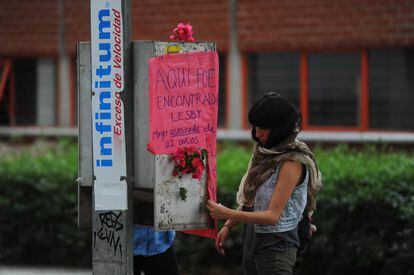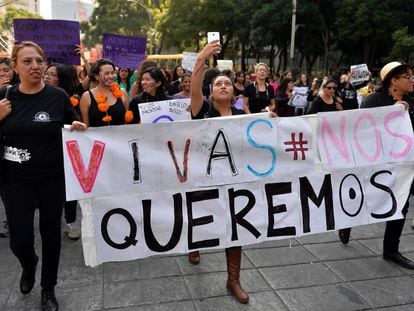Outrage in Mexico over prosecutor’s description of strangled woman
The 22-year-old victim was described as a bad student and an alcoholic who might have killed herself

Students and faculty at Mexico’s National Autonomous University (UNAM) awoke on Wednesday to news of the death of Lesby Berlín Osorio, a 22-year-old whose body was found at a phone booth near the School of Engineering. She had been strangled with the telephone cable, and her hand was still holding a dog leash.

Two days later, controversy broke out over the way that the Mexico City prosecutor’s office described the victim. “She was an alcoholic and a bad student.” “She was shooting up with some friends.” “She had left home and was living out of wedlock with her boyfriend.” These are some of the descriptions, shared on social media, whose tone has sparked outrage in a country struggling with sexist violence.
Thousands of women are using Twitter to ask: “If I get killed, what will they say about me?” The hashtag #SiMeMatan (#IfTheyKillMe) has been used to accompany personal testimony from women wondering how they would be judged, and the university community has called a protest march for Friday to demand justice for the victims of gender violence.
She had left home and was living out of wedlock with her boyfriend
Prosecutor’s report
Following the social media outrage, Mexico City prosecutor Rodolfo Ríos tweeted that he had ordered the online comments made by his agency’s social communications department removed.
“Never will the conduct, private life or social condition of a victim affect an investigation. I have issued orders to rectify this serious mistake,” he tweeted.
An average of seven women are murdered in Mexico every day. Most of them suffer a violent demise, with methods including strangulation, stabbing or being burnt to death, according to the National Statistics Institute.
According to testimony provided by her boyfriend, José Luis González, Lesby was with him and several other friends on campus on the night of her death. When he decided to leave, Lesby followed him. It was 4am. At that point they had an argument, and they parted ways, the boyfriend told the police. Hours later he found out that she was dead, according to his statement.
“Never will the conduct, private life or social condition of a victim affect an investigation. I have issued orders to rectify this serious mistake”
The preliminary investigation points to González as the main suspect of what appears to be a case of murder. But authorities are not ruling out the possibility that a third party attacked her when she and her boyfriend went their separate ways, or even that she might have committed suicide.
Lesby had moved in with González because, as her mother said, “I didn’t know what to do with her anymore.” Both youths had part-time jobs: Lesby was a dog walker and González worked as a janitor at a public high school. People who knew both of them said that the couple “argued a lot” and had drug and alcohol problems. González was still drunk when he was arrested, and was unable to provide a statement until several hours later, according to sources at the prosecutor’s office.
The UNAM campus is a green oasis for Mexico City’s youth. The sheer size of Latin America’s largest higher education center, with 300,000 enrolled students, makes it impossible for the police to patrol its avenues. There are no walls – the campus is open – as a way to integrate the university into the city and vice versa. Lesby and González lived in the area, but they were not UNAM students.
English version by Susana Urra.












































